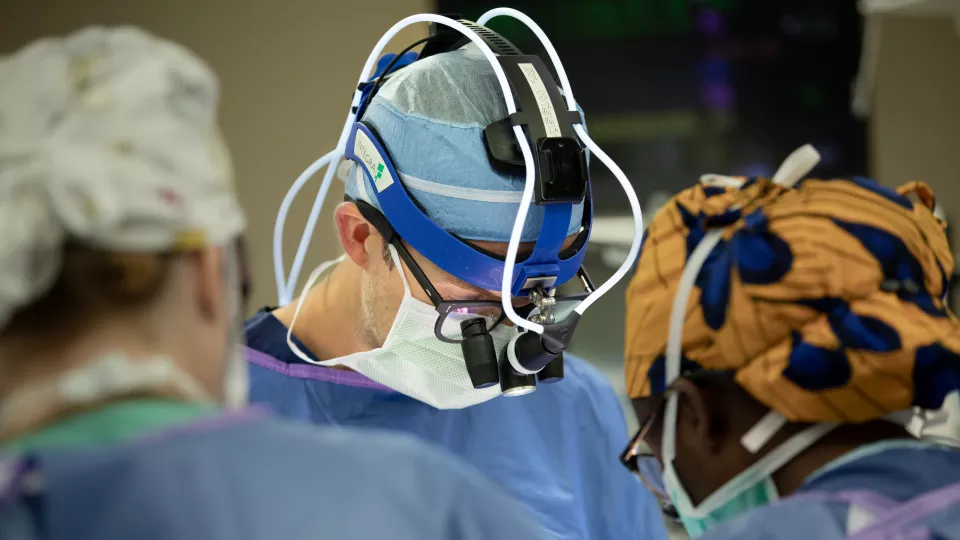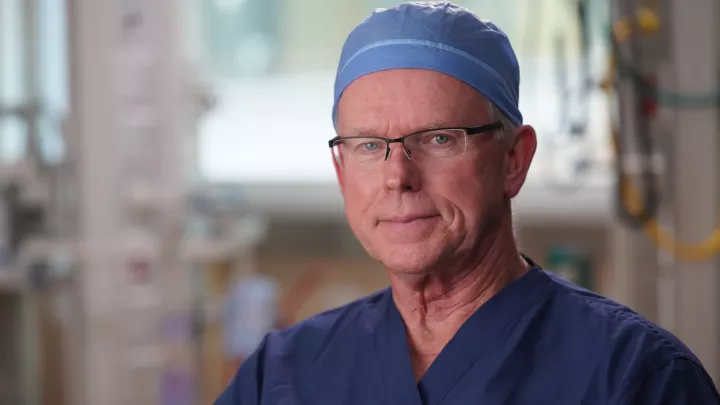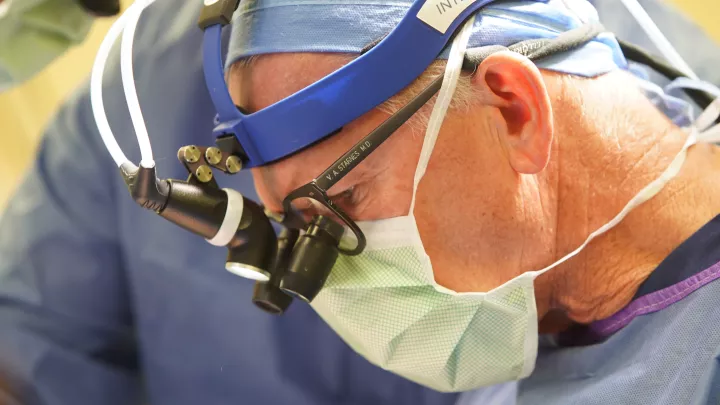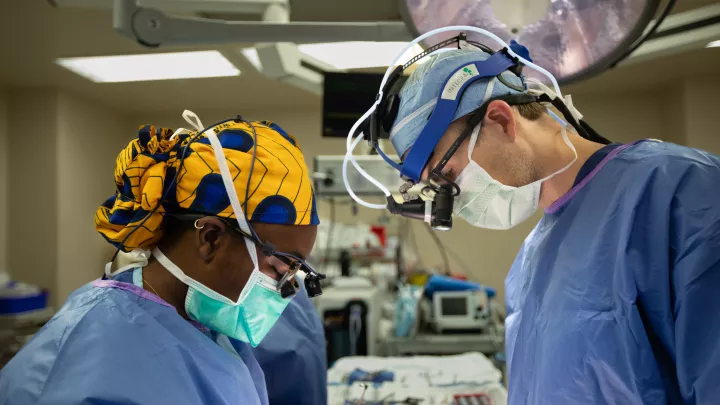
Luke Wiggins, MD, and Heart Institute team members in the operating room at Children’s Hospital Los Angeles
Managing Congenital Aortic Stenosis in the Operating Room
On Aug. 28, Children’s Hospital Los Angeles hosted a special educational symposium on “Aortic Valve Stenosis: From Fetus to Adult” at the 8th World Congress of Pediatric Cardiology and Cardiac Surgery in Washington, D.C.
The dinner event—which was moderated by Paul Kantor, MBBCh, MSc, FRCPC, Chief of Cardiology and Co-Director of the Heart Institute—attracted nearly 300 attendees and featured multiple Heart Institute faculty, who reviewed the diagnosis and management challenges of congenital aortic valve stenosis across the age spectrum.
Among the presenters was Attending Cardiothoracic Surgeon Luke Wiggins, MD. “Aortic valve stenosis is a complex condition that requires multidisciplinary care at an experienced center like Children’s Hospital Los Angeles,” Dr. Wiggins says. “Each patient is unique, and it’s important to develop an individualized plan.”
Dr. Wiggins shares key points from his talk, which covered a breadth of surgical approaches for this condition.
Surgical valvotomy

Surgical aortic valvotomy, which aims to open the valve to allow better blood flow, is often one of the first surgical approaches used to treat aortic stenosis in young patients.
“In nearly half the cases of infants and older children, a simple valve debridement is all that’s needed to improve blood flow and achieve a satisfactory result,” Dr. Wiggins says.
There is some debate in the field over whether it is best to perform a surgical aortic valvotomy or a balloon aortic valvuloplasty in the catheterization lab. One potential problem with the balloon approach, he notes, is that it is less precise. That lack of precision can sometimes injure leaflet tissue and cause aortic valve insufficiency, as well as make it more challenging to repair the valve later on.
Although there are some conflicting reports in the literature, some studies have shown improved short- and long-term survival with a surgical valvotomy over the balloon approach. But Dr. Wiggins stresses that it is not a one-size-fits-all decision.
“It really depends on the presentation of the patient,” he notes. “At our center we take a team approach, with interventional cardiologists, cardiologists, imaging specialists and surgeons all working together to choose the best procedure for each child.”
Aortic valve repair
Children’s Hospital Los Angeles has extensive experience in all facets of aortic valve repair techniques. “Several factors impact the ability to repair the valve, but that’s always our first goal,” Dr. Wiggins says. “If possible, we want children to be able to keep the valve they were born with.”
Leaflet replacement is one approach that has been applied to pediatric patients in recent years. This technique typically uses material from the child’s pericardium or a commercial material called CardioCel to construct new aortic valve leaflets using specific templates.
While this repair has promise, patient selection is key, he says. The biggest challenge, as with other aortic valve repairs, is longevity.
“The more complex the repair, the less longevity it tends to have,” Dr. Wiggins explains. “This is primarily due to the rapid degeneration of patch materials from fibrosis, retraction or calcification. However, complex valve repair can still be the best answer for certain patients, particularly those who are not candidates for the Ross procedure or for long-term blood thinner therapy.”
Aortic valve replacement
A replacement valve should only be considered when repair options have been exhausted, he notes. That’s because many prosthetic aortic valves for children come with significant downsides.
“Unfortunately, a child can outgrow a prosthetic valve very quickly,” Dr. Wiggins says. “Children also have heightened immune systems that tend to break down bioprosthetic valves. Mechanical valves can be longer lasting, but a child has to be on long-term blood thinner therapy.”
One alternative is the Ross procedure, which uses the child’s own pulmonary valve as an aortic valve. The valve then grows with the child over time, and long-term anti-coagulation is not needed.
Children’s Hospital Los Angeles is one of the few centers in the world that can perform this technically demanding operation in neonates. Last year, the team published results of a 27-year retrospective study on infants and neonates who underwent the Ross at CHLA.
The study—the largest in the world from a single center—demonstrated that the Ross has excellent durability in these young patients, with 96% not needing left ventricular outflow re-intervention after 15 years.
“Our institution has shown that the Ross can be performed with a short bypass run, a median hospital stay of four to 10 days, and low morbidity and excellent survival in patients younger than 20 years of age,” Dr. Wiggins says.
Still, as with other therapeutic options for this disorder, treatment must be tailored to each patient.
“At Children’s Hospital Los Angeles we have experience in all of these techniques,” Dr. Wiggins says. “Each child can have a very different presentation. It’s critical to work as a multidisciplinary team to choose the best approach for each child.”



